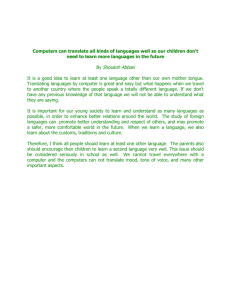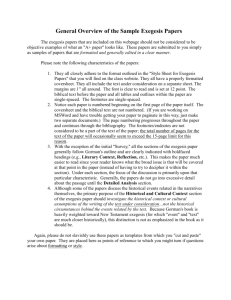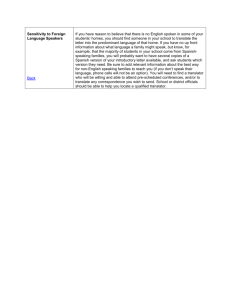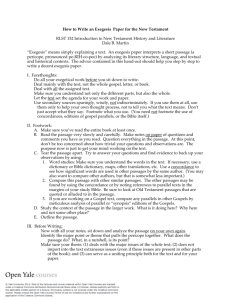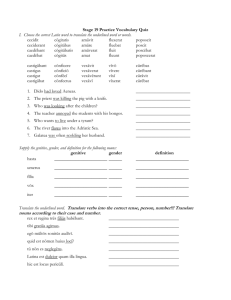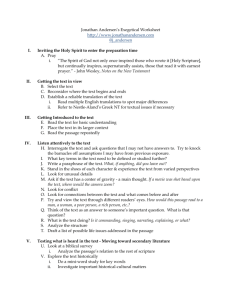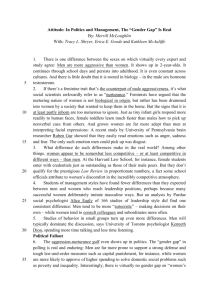Hebrew Exegesis Spring OT 506 2016 John D. Currid Tuesday 8:00
advertisement
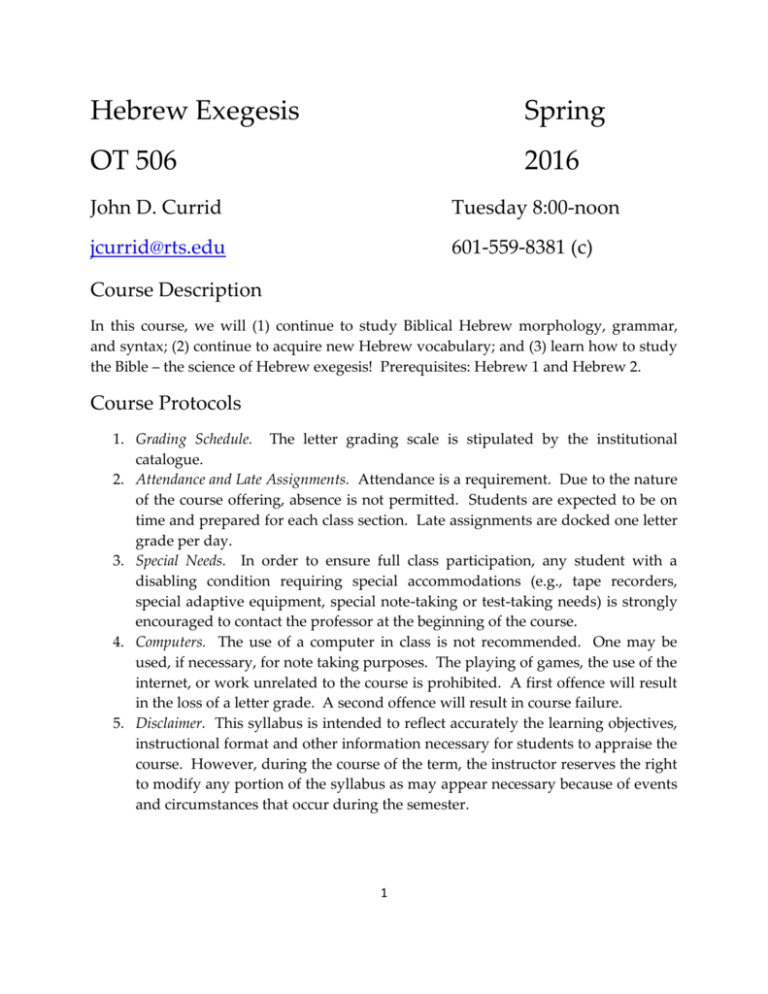
Hebrew Exegesis Spring OT 506 2016 John D. Currid Tuesday 8:00-noon jcurrid@rts.edu 601-559-8381 (c) Course Description In this course, we will (1) continue to study Biblical Hebrew morphology, grammar, and syntax; (2) continue to acquire new Hebrew vocabulary; and (3) learn how to study the Bible – the science of Hebrew exegesis! Prerequisites: Hebrew 1 and Hebrew 2. Course Protocols 1. Grading Schedule. The letter grading scale is stipulated by the institutional catalogue. 2. Attendance and Late Assignments. Attendance is a requirement. Due to the nature of the course offering, absence is not permitted. Students are expected to be on time and prepared for each class section. Late assignments are docked one letter grade per day. 3. Special Needs. In order to ensure full class participation, any student with a disabling condition requiring special accommodations (e.g., tape recorders, special adaptive equipment, special note-taking or test-taking needs) is strongly encouraged to contact the professor at the beginning of the course. 4. Computers. The use of a computer in class is not recommended. One may be used, if necessary, for note taking purposes. The playing of games, the use of the internet, or work unrelated to the course is prohibited. A first offence will result in the loss of a letter grade. A second offence will result in course failure. 5. Disclaimer. This syllabus is intended to reflect accurately the learning objectives, instructional format and other information necessary for students to appraise the course. However, during the course of the term, the instructor reserves the right to modify any portion of the syllabus as may appear necessary because of events and circumstances that occur during the semester. 1 Textbooks 1. Brotzman, Ellis R. Old Testament Textual Criticism: A Practical Introduction. Grand Rapids: Baker, 1994. 2. Stuart, D. K. Old Testament Exegesis, 4th ed. Louisville, KY: Westminster/John Knox Press, 2009. Course Requirements 1. We will read the story of Samson in the Book of Judges, selected Psalms, and Isaiah 43. Translations will be turned in on the last day of class, May 3. 2. Major exegesis paper. 80% of the final grade. Due on May 3. 3. Two major quizzes will be given. The first will be on the translation of Judges 14:1-16:31 and the second on translation of the Psalms. 20% of the final grade. Course Schedule February 2 Introduction and Syllabus History of Interpretation February 9 Translate Judges 14:1-9. Introduction to BHS. Assignment: Select and translate a narrative passage from the OT for your exegesis paper. The pericope should be between 8-10 verses in length. Read Stuart, 1-31. February 16 Translate Judges 14:10-20. Textual Criticism. Assignment: Enter the Hebrew text of your passage into your word processor and, in footnotes, translate the textual apparatus of BHS and comment on any other textual issues. Read Brotzman, 17-132. February 23 Translate Judges 15:1-13. Lexical Studies. Assignment: Select two important words from your text and conduct a thorough word study of each. Type a one page summary of each study. March 1 Translate Judges 15:14-20. Grammatical and Syntactical Analysis. Assignment: Make a list of 25 grammatical and syntactical observations related to your text. You should make reference to grammars such as Jouon-Muraoka, Waltke and O’Connor, Arnold and Choi, etc. 2 March 18 Translate Judges 16:1-14. Structure. Assignment: produce a formal outline of your text. March 15 Spring Break March 22 Translate Judges 16:15-31. Literary Context. Assignment: Using any necessary secondary literature (see Stuart, 118-125), identify the genre of your text and demonstrate the significance of this literary type for your text. Quiz #1. March 29 Translate Psalm 1:1-6. Historical Context. Assignment: Write a one page summary describing the historical context of your text. April 5 Translate Psalm 23:1-6. Biblical Context. Assignment: Identify the appearance of your passage elsewhere in either the OT or the NT. Do these texts help to interpret, explain, or apply your text? Make a list of references and briefly explain what these passages contribute to your understanding and interpretation of the text. April 12 Translate Psalm 134:1-3; 136:1-13. Systematic Theology. Assignment: To what categories of systematic theology does your passage contribute? Select one appropriate category from systematic theology and write a one page summary detailing how your passage contributes to this area of study. Quiz #2. April 19 Translate Psalm 136:14-26; Isaiah 43:1-3. Secondary Literature. Assignment: Create the bibliography for your paper. List only those works cited in the footnotes or body of your paper. Be certain that your bibliographic entries comply with the appropriate format. April 26 Translate Isaiah 43:11-21. Application. Assignment: Apply the message of your passage to the life of the modern day believer. How does the passage speak to us today? From Exegesis to Sermon Preparation. Assignment: Create a one-page sermon outline based on your text. May 3 Translate Isaiah 43:22-28. Turn in your final exegesis paper. 3 Exegesis Paper Your exegesis paper must include the following items. Before you turn in your final paper, you must have a fellow student read, edit, and sign the last page of the bibliography. (See example of Heb. Ex. paper on RTS-Charlotte web-site.) 1. Title Page. See attached example. 2. Hebrew Text. The first step is to import the Hebrew text into your word processing application. At this point, footnote and discuss any relevant text critical issues that appear in the textual apparatus or secondary literature. 3. English Translation. Provide your own translation of the Hebrew text. Footnote any relevant information that relates to your translation. For example, you may comment on how your translation differs from one or more of the standard English Bibles. 4. Introduction and Outline. Give a basic introduction to the content and structure of your passage. In other words, provide the big picture before you begin the verse by verse commentary. 5. Verse by Verse Commentary. Describe the basic content of each verse. Detailed analysis of grammar, syntax, word studies, and historical issues are to be considered. 6. Theological Summary and Conclusions. Tie it all together! This is the “so what” section of the paper. What is the biblical-theological contribution of this passage to the larger narrative complex and to the whole of Scripture? How does it fit in the unfolding of God’s redemptive history? What does your passage teach us of Christian living? 7. Sermon Outline. preach. Create a one page sermon outline from which you could 8. Bibliography. Provide a complete listing of all secondary literature cited in your paper. Entries may include Hebrew grammars, lexicons, word study books, monographs, dissertations, journal articles, or commentaries. Note that one’s consultation of commentaries should be restricted to the final stages of study. It is important that you develop your own exegetical skills rather than rely upon the work of others. 4 Strike that Rock! A Study of Exodus 17:1-7 A Paper Presented to Dr. John D. Currid Reformed Theological Seminary (Charlotte) In Partial Fulfillment of the Requirements for Hebrew Exegesis (OT 506) By Joe Student May 3, 2016 5 6
